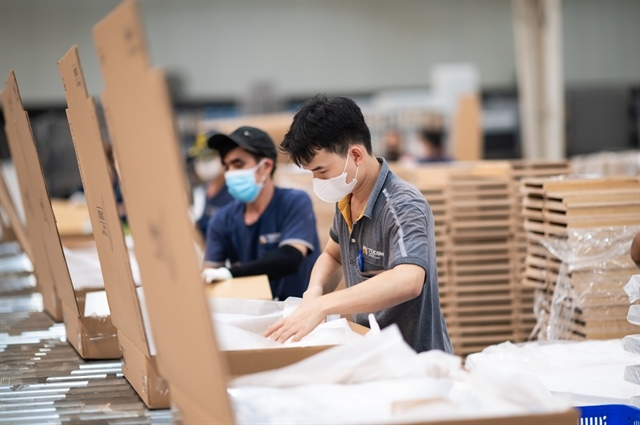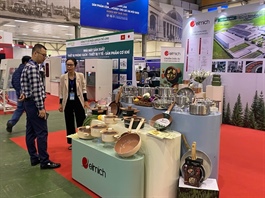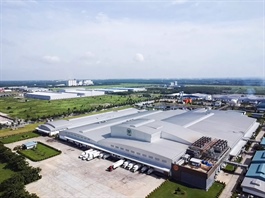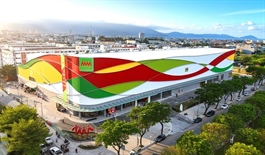Wood exporters turning challenges into opportunities
Wood exporters turning challenges into opportunities
The industry is undergoing a positive transition. If pursued decisively, Việt Nam could establish a lasting competitive advantage in the global plywood market, according to experts.

Workers package kitchen cabinets for export. — Photo courtesy of the company |
The increasing tariff and non-tariff trade barriers in major markets such as the US and Europe are not fazing Vietnamese wood exporters, who are turning them into opportunities by accelerating transformation, strengthening compliance and moving up the value chain to build long-term competitiveness.
Speaking to the media during a factory visit at Nam Tân Uyên Expansion Industrial Park, Vũ Quang Huy, chairman and CEO of TEKCOM Corporation, which exports plywood and associated products to more than 50 markets including the EU, US, India and Southeast Asia, said businesses faced numerous trade barriers.
“These are largely beyond our control. What matters is how we adapt and transform."
Asked about the impact of the US’s 25 per cent tariff on kitchen cabinets, he said TEKCOM’s orders and operations remained steady due to careful planning.
“The US does not have a production advantage in the wood sector and will continue to import. The key question is how tariffs are applied to countries competing with Việt Nam and what solutions local companies take to adapt swiftly.”
In the kitchen cabinet segment, his company develops product lines tailored to specific customer groups in each market.
“By working closely with tier-one customers, we co-design products that meet demand," he said, adding that prices are kept competitive through optimised materials, ensuring a long-term advantage.
The company is also exploring new partnerships to participate more deeply in the value chain, develop brands, and build future distribution channels.
Speaking about non-tariff barriers, he said each market would have its own standards for plywood – like BIS (India), IMANOR (Morocco) and EUDR (Europe), along with the requirement to use legally-sourced and traceable wood.
His company is one of the first plywood manufacturers in Việt Nam to meet IMANOR standards and is working with partners to ensure full compliance with EUDR requirements.
“In a fast-changing world, tariffs and trade barriers can become opportunities. Businesses able to adapt quickly will move ahead.”
Opportunities from plywood

Workers package kitchen cabinets for export. — Photo courtesy of the company |
Việt Nam produces more than 3.7 million cubic metres of plywood annually.
With China’s output declining from 90 per cent to 60 per cent of global production and continuing to fall, opportunities are increasing for countries such as Việt Nam.
“Producing plywood requires both planted forests and a complete supply chain, areas where Việt Nam has a competitive edge thanks to its robust supply chain and competitive costs," Vũ said.
However, he also noted some limitations facing the sector.
Việt Nam has around five million hectares of planted forests, primarily acacia, rubber, and eucalyptus, but they mostly supply base plywood rather than high-quality veneer, requiring some imports.
Another challenge is that the country has yet to establish a distinct wood brand or high-value plywood products, unlike its competitors. Russia and Europe have birch, China has poplar, Indonesia and Malaysia have meranti and falcata, and Brazil and Chile have eucalyptus and pine.
Việt Nam’s acacia remains largely used for low-value segments such as construction and packaging.
To increase the value of the plywood sector, it is essential to focus on rubberwood, gaining a deep understanding of market needs and investing in technology and R&D for product development, and this is what many companies are doing, according to Vũ.
While rubberwood has long been used in the furniture, there remains significant untapped potential in the plywood sector. Rubberwood plywood can serve as a substitute for Russian birch plywood in Europe, as it is comparable in quality and decorative use. Importantly, all rubberwood plantations have legal and fully traceable origins.
“The industry is undergoing a positive transition. If pursued decisively, Việt Nam could establish a lasting competitive advantage in the global plywood market,” he said.
According to Phùng Quốc Mẫn, chairman of the Handicraft and Wood Industry Association of HCM City, the wood industry has become one of Việt Nam’s most remarkable export success stories.
In 1999 exports were under US$200 million and this year they are projected to reach $20 billion.
The industry has built a relatively complete supply chain, from raw materials to production and distribution, creating a strong global competitive advantage.
Việt Nam is the world’s second largest furniture exporter after China, and ships its wood products to 166 countries and territories.
In 2024 the industry recorded a trade surplus of $14.5 billion.
- 09:13 18/11/2025























